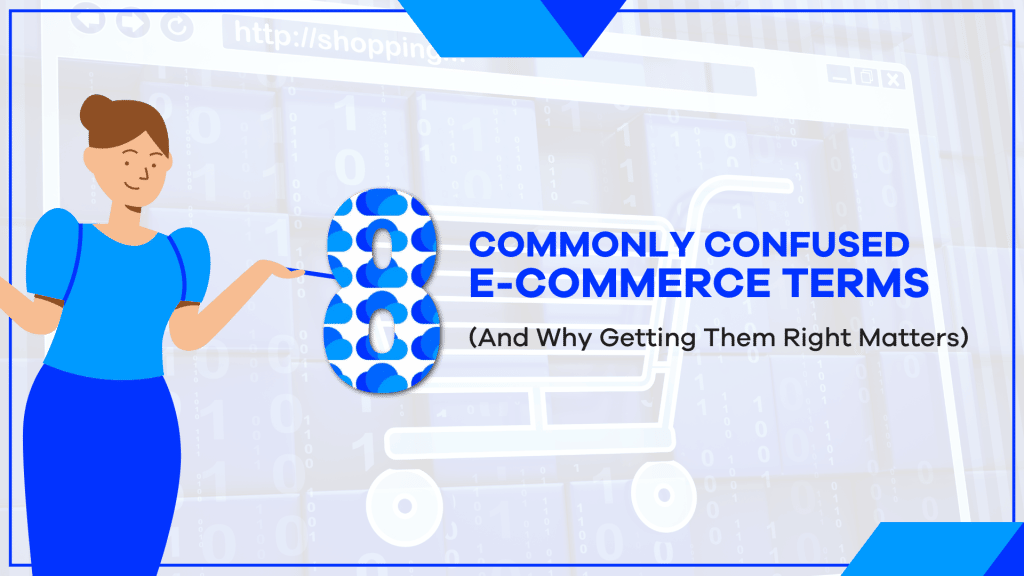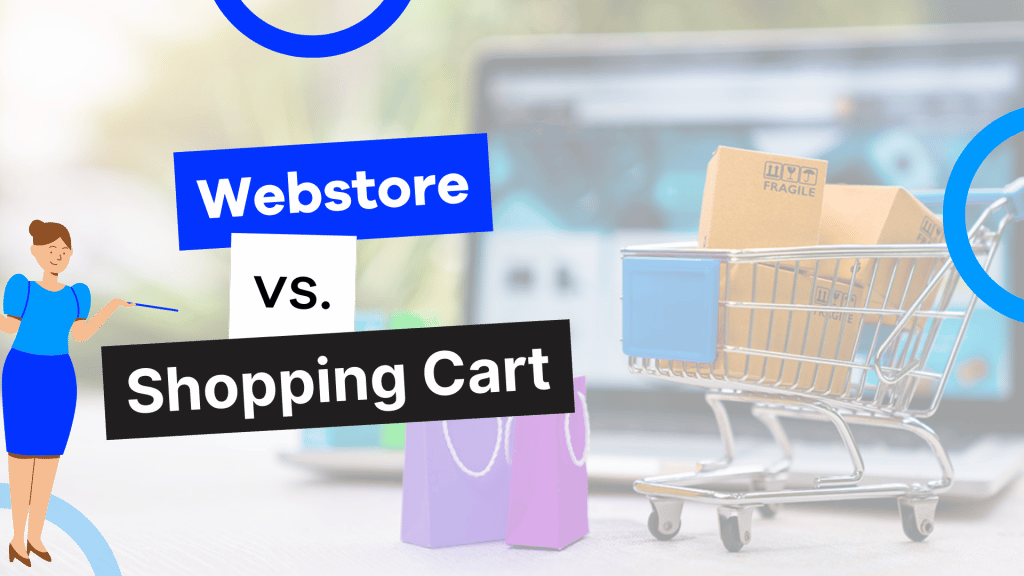
Like every industry, ecommerce has its own jargon and buzzwords. Many of the terms are so similar that they become easily confused and misused. That said, the differences in meaning between some of ecommerce’s most similar words and expressions are often critical.
Failing to recognize these differences can affect the clarity of your brand and messaging and interfere with the effectiveness of your ecommerce business practices. Avoiding these common mix-ups will help ensure that your omnichannel ecommerce company can communicate and operate effectively.
Ecommerce Marketplace vs. Ecommerce Platform
An ecommerce marketplace is a third-party site where multiple vendors list and sell products to customers. The role of the marketplace is to surface products relevant to customers’ shopping intent and then facilitate the resulting sales conversions and transactions. Each marketplace collects fees based on factors such as listing type, final sale costs, and advertising costs.
In most cases, all customer-seller contact is facilitated through the marketplace. Some of the most popular examples of ecommerce marketplaces include Amazon, eBay, and Walmart.com.
Marketplaces make it easy for businesses to start selling online. There is a low barrier to entry and an established customer base for sellers to tap into instantly. Some marketplaces even offer logistical support—like Amazon’s Fulfillment by Amazon (FBA) program—to ease the fulfillment burdens associated with a growing ecommerce brand.
An ecommerce platform connects customers and sellers, but it does so with less intrusion from an intermediary than sellers would face when selling on an ecommerce marketplace. Ecommerce platforms are useful for brands looking to use their own webstores to sell directly to customers.
Doing so reduces the costs associated with marketplace fees while also allowing more granular control over the products you sell, customer communication, and listing content. The result is a sales experience that is devoid of on-site competition and more effective at building both your brand and customer loyalty.
Some ecommerce solutions, like Descartes Sellercloud, make it possible to get the best of both worlds. Our growth-focused, omnichannel platform features a wide array of integrations and tools that allow sellers to convert sales and fulfill orders across third-party marketplaces and their own web pages. Additional features allow you to manage your catalog, inventory, and warehousing logistics across multiple online retail environments.
Multichannel Ecommerce vs. Omnichannel Ecommerce
In today’s ecommerce industry, selling on a single channel is a surefire way to put your business at a competitive disadvantage. Instead, most businesses adopt either a multi-channel or omnichannel approach to listing and marketing their products. Both strategies are similar in that they involve broadening a brand’s online reach, but they achieve these ends in different philosophical ways.
Multichannel ecommerce is a product-focused approach to marketing. The goal is to list your product on multiple, unique channels and increase the odds of reaching more potential customers. A multi-channel strategy can involve a combination of both first- and third-party sales. It can also include a variety of channels, marketplaces, social media sites, and webstores. Ultimately, the strategy hinges on widespread product exposure above all else.
Omnichannel ecommerce is a more immersive, customer-focused style of online retail. Rather than simply listing a product across multiple channels, sellers craft a brand that offers unified, immersive engagement opportunities regardless of where or how a customer encounters the business or its products. This means that marketplace listings, webstores, mobile experiences, social media, and advertising all work in tandem to cultivate a singular experience that promotes customer engagement, drive sales conversions, and builds brand loyalty.
While Descartes Sellercloud can be used as a multi-channel ecommerce tool, it shines as a vehicle for omnichannel growth. Our catalog features allow you to craft listings and media that can be used everywhere your brand lists products. Furthermore, our warehouse and inventory management features allow you to streamline your fulfillment workflows to support sales wherever they originate.
The result is an optimized, end-to-end customer experience that can be leveraged to scale and develop your ecommerce business.
First-party (1P) Sales vs. Third-party (3P) Sales
First-party sales are direct-to-consumer (D2C) transactions that do not involve any middleman or marketplace. In 1P ecommerce, the sellers are wholesalers—they sell products directly to their customers without the additional rules and regulations typical of 3P sales. As a result, sellers have increased freedom to dictate terms, collect useful business intelligence data, and market to new and existing customers.
Third-party sales are conducted through an intermediary—like a marketplace or a retailer. These opportunities can effectively allow brands to access some of the world’s largest, most established online customer bases. However, as previously mentioned, 3P sales experiences come with strings attached that are less conducive to cultivating long-term brand growth and customer loyalty.
Descartes Sellercloud supports both 1P and 3P sales. Both can be instrumental in growing your ecommerce brand, but 1P sales certainly provide uniquely profitable opportunities that 3P cannot. For more on these key differences, check out our guide about why you should transform your third-party sales into a first-party business.

Webstore vs. Shopping Cart
A webstore, sometimes called an ecommerce website, is a webpage where sellers sell directly to their customers. Sellers can create and customize every aspect of their virtual storefront to match their products and branding. On the back end, webstores can use algorithms to facilitate effective on-site search experiences, gather useful customer data, and even promote up-selling and cross-selling opportunities.
Some third-party marketplaces offer their own take on webstores, allowing customers to view a brand or business’s available listings in one place. Some even offer sellers the opportunity to design the layout and choose which items to feature prominently on their marketplace webstores.
That said, marketplaces are not especially concerned with the success of your individual business. The goal is to drive as many conversions as possible, regardless of the seller. As such, sellers should always expect to contend with advertising and cross-selling links for competitors’ products, even on seller-specific website pages.
Conversely, first-party webstores allow ecommerce businesses to create a customer experience without competitors.
A shopping cart in ecommerce performs similarly to a shopping cart in a brick-and-mortar store. As customers shop on an ecommerce website, they add merchandise to their virtual basket. Once the customer is ready to check out, the shopping cart framework is used to accept payment and coordinate fulfillment choices.
Most ecommerce businesses rely on third-party shopping carts as the backbone of their point-of-sale (POS) infrastructure. Shopping carts are extremely useful for creating functional ecommerce websites that can securely handle order processing. Furthermore, shopping cart platforms make it simple to offer customers a variety of payment choices and shipping options.
While webstores can create and code the same functions without the support of a third-party shopping cart framework, the versatility and reliability of popular shopping cart platforms like Shopify, BigCommerce, Magento, and WooCommerce make outsourcing the POS functions to a shopping cart platform a logical choice for most ecommerce businesses.
In addition, many shopping carts have expanded their offerings to include webstore design and hosting capabilities. Data analysis, coupon functionality, cross-selling suggestions, SEO analysis, and order-tracking features are additional value-adds that can make a shopping cart particularly attractive.
Descartes Sellercloud supports several industry-leading shopping cart platforms while also providing ecommerce businesses with the tools they need to run D2C webstores. The Descartes Sellercloud platform can sync prices, product details, inventory levels, and order data across all shopping carts, webstores, and third-party marketplaces in your omnichannel business plan.
For omnichannel sellers, the ability to consolidate all these areas of their operation with a unified platform is critical to optimizing their business’s profitability and efficiency.
For more on how Descartes Sellercloud can help take your ecommerce business to new heights, contact us directly for a free demo.




